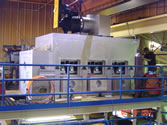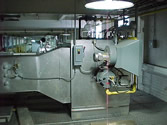Log in
Cire Technologies Blog
Principles of Direct Impingement Dryer Design Series – Paper No. 5 of 8
Dryer Design Characteristics that Affect Dryer Heat Transfer Coefficients
Good dryer design requires the designer to weigh the three factors that go into the quantity of heat transferred to the product with the rate that the product can accept the drying force without adversely affecting the product characteristics. The three factors are seen in the fundamental equation of forced convection heat transfer defined in an earlier paper.
q=H•A•(TA-TS)
Because TS for a given product, the temperature of the web during the evaporation phase, is the same regardless of the dryer configuration we see that the quantity of heat transfer is affected by the heat transfer coefficient, H, the drying area of the dryer, A, and the temperature of the supply air, TA. For each product dried there are limitations on the supply air temperature and rate of heat transfer, H, that can be applied without harming the finished product. These can be determined by experimentation or experience.
After you determine the heat transfer coefficient that you need to dry the product without adversely affecting its properties you will need to design the dryer configuration to meet that H value. There are five variables that go into the impingement dryer design that impact the resulting heat transfer capability of the dryer. Depending on the design of the dryer most of these will be fixed by the dryer design, typically three. Good design weighs these variables and their trade-offs to yield the most efficient system, thus minimizing operating cost. The design variables are:
- Nozzle spacing in the direction of web movement.
- The width of the nozzle opening.
- The throw distance between the nozzle and the web.
- The velocity of air leaving the nozzle.
- The supply air temperature.
The temperature of the supply air has a small effect on the heat transfer coefficient with lower temperature dryers yielding higher heat transfer coefficients than high temperature dryers, with all other variables equal...
Because it is not a factor associated with the layout of the dryer, which is the focus of this paper, a detailed discussion about supply air temperature's effect on H is not offered here.
The nozzle design we recommend for most direct impingement applications blows perpendicular to the web because that yields the greatest heat transfer for a given air flow. In addition we recommend two dimensional continuous slot nozzles across the full width of the web instead of a multiplicity of round orifices because we can collect the exhaust from the nozzles more efficiently and uniformly, resulting in a more uniformly dried product.
The point where the air jet leaves the nozzle is the Vena Contracta, the point where the velocity is greatest and the width of the air flow is least. The air then enters the transition zone where it transitions from a thin laminar flow to a wider, turbulent flow. The air jet then impacts the web and coating to penetrate the boundary layer at the surface of the web. The most effective heat transfer is directly below the centerline of the nozzle slot and the effectiveness diminishes as the distance from the centerline increases until the effects of the next nozzle are felt. The heat transfer coefficient used for dryer design is therefore the average of the heat transfer gradient from one nozzle to the next.
Nozzle Spacing
If all other variables stay the same, changing the nozzle spacing will vary the effective heat transfer in a linear relationship. This is intuitively obvious, the more nozzles across the web the more often the boundary layer at the product is broken and the more effective the drying. The relationship has diminishing returns however as doubling the number of nozzles will have a smaller impact the closer the nozzles are to each other. When selecting the nozzle spacing the designer has to weigh the added capital and operating cost of adding nozzles which consequently increases the supply fan size and horsepower against the higher heat transfer capability.
Nozzle Slot Width/Throw Distance
The nozzle slot width is the opening dimension of the slot nozzle in the direction of web travel. These typically are less than 1/4inch, often less than 1/8inch. The nozzle slot width and the distance between the nozzle and the web are interrelated. Typical nozzle to web distances can vary from as little as 1/2 inch or closer to 6 inches and even further.
There is a relationship between the slot width and the effective distance of the air hitting the web. As the slot orifice increases in width the impact velocity on the web increases. This effect levels out at a distance of six to four times the slot width away from the discharge point. Because wider nozzle slots obviously increase the air flow of the dryer for a given supply air velocity the designer must weigh the relationship between the slot width and distance away from the web surface to minimize the energy required to deliver the work to the web. Though other factors may affect the dryer design, generally narrower nozzles, closer to the web will deliver you heat transfer most efficiently.
Supply Air Velocity
The nozzle exist velocity will change the value of H at a rate of velocity V0.6. The greater the velocity the higher the heat transfer. As with other variables the designer has to weigh the benefit of a higher velocity verses the cost in fan horsepower to deliver the higher velocity. In addition the ability of the product coating to resist damage from ever higher velocities must be considered.
Dryer design must consider all these variables to yield the best design to meet the need of the product. Where products vary for the same dryer consideration should be made to provide flexibility in delivered heat transfer capabilities. Typically nozzle spacing is set by the initial design and cannot be changed. In some designs the nozzle slot width can be adjusted but this should not be done on a regular basis as repeatability will be difficult and with many nozzles in a dryer it would be too labor intensive.
One obvious variable that can be easily changed is the supply air velocity. We always include variable speed drives on the motors of our supply and exhaust fans to provide the flexibility to easily and accurately dial in different supply velocities and thus different heat transfer characteristics.
An additional variable that is easily changed that changes the quantity of heat transfer would be to change the supply air temperature. As seen in the quantity of heat transfer formula, the quantity of heat transferred varies directly to the temperature differential between the supply air and the web surface temperature.
Lastly we have built successful dryers that can vary the distance from the nozzle to the web surface automatically and accurately. We have found this option useful where products processed by a dryer vary drastically. This option can create dramatically different drying heat transfer characteristics within the same dryer.
In the next paper on impingement dryers we will discuss the components of a impingement dryer system and good design characteristics used in their selection.
When you subscribe to the blog, we will send you an e-mail when there are new updates on the site so you wouldn't miss them.





Comments